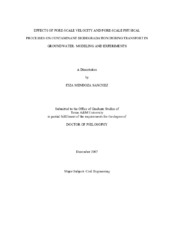| dc.description.abstract | Contamination of surface and ground water has emerged as one of the most important
environmental issues in developed and developing countries. Bioremediation of
groundwater takes advantage of bacteria present in the environment to transform toxic
compounds to non-toxic metabolites. This biotechnology holds the potential for fast,
inexpensive, and effective water decontamination. However, it is still poorly understood
and usually not fully controlled due to the lack of information describing the natural
phenomena involved. Therefore, a better understanding of the phenomena involved
during bioremediation of groundwater could help in the design and implementation of
more efficient technologies.
The main objective of the present research is to assess how pore-scale physical
factors, such as pore-scale velocity, affect the degradation potential of contaminants during transport in groundwater. The target chemicals studied were chlorinated ethenes
because they are commonly found in contaminated groundwater sites.
To achieve the research objective, the following were employed: a mathematical
model that links pore scale processes to the macro-scale representation of contaminant
transport; development of numerical tools to solve the mathematical model; and
experimental elucidation of the influence of pore-scale flow velocity on the
biodegradation of contaminants using column experiments. Results from the
mathematical model and experiments were used to elucidate the inter-relationship
between physical and biological phenomena at the micro scale. The influence of flow
velocity through the porous media (a physical factor) on the biological structure
(microbial community in the porous media) was assessed.
The results of this investigation contribute to the bioremediation of contaminated
groundwater understanding with new insights on the importance of physical transport
factors on the biodegradation potential. For example, flow velocity is shown to have an
important effect on the degradation potential of chlorinated ethenes. Additionally, the
mathematical model and numerical tools have potential application to many other
reactive transport problems, including: adsorption onto activated carbon, reaction in
packed beds of catalyst, chemical transport in streambeds, and separation in
chromatographic columns. | en |


